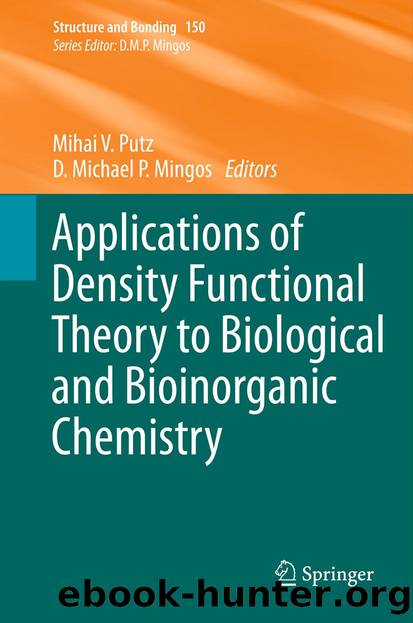Applications of Density Functional Theory to Biological and Bioinorganic Chemistry by Mihai V. Putz & D. Michael P. Mingos

Author:Mihai V. Putz & D. Michael P. Mingos
Language: eng
Format: epub
Publisher: Springer Berlin Heidelberg, Berlin, Heidelberg
3.2 Nitrite and Nitrate
Nitrite binding to metals is well known in traditional inorganic chemistry as an example of linkage isomerism—occurring either via the nitrogen or via the oxygen atom, cf. Fig. 5. In the past few years it has been recognized that the same linkage isomerism is also at work in metalloproteins [30, 52–56]. An initial DFT prediction was made despite a wealth of experimental data showing nitrite binding to hemoproteins only via its nitrogen atom, binding via the oxygen should also be possible [30]. Soon afterwards, the crystal structures of nitrite-bound myoglobin and hemoglobin were reported, showing indeed the DFT-predicted isomer [52–56]. Subsequent detailed studies, with DFT, ab initio dynamics, and QM/MM approaches [57] have also revealed that nitrite reduction is almost equally feasible via the two isomers, suggesting perhaps one more case of mechanistic promiscuity, as illustrated in Fig. 5 [57]. Also based on DFT data, linkage isomerism was proposed to be feasible in copper-containing nitrite reductases [58], as well as in molybdenum-containing nitrate reductases—as the latter enzymes can reduce nitrite at competition with nitrate [32]. In the case of nitrate reductase, nitrate and nitrite were computed to be reducible at very similar rates [32].
Fig. 5Nitrite linkage isomerism and reduction at hemoprotein active sites
Download
This site does not store any files on its server. We only index and link to content provided by other sites. Please contact the content providers to delete copyright contents if any and email us, we'll remove relevant links or contents immediately.
Alchemy and Alchemists by C. J. S. Thompson(3304)
The Elements by Theodore Gray(2858)
The Club by A.L. Brooks(2758)
How to Make Your Own Soap by Sally Hornsey(2748)
Drugs Unlimited by Mike Power(2490)
Wheels of Life by Anodea Judith(1924)
Cracking the Sat French Subject Test, 2013-2014 Edition by The Princeton Review(1772)
Perfume by Jean-Claude Ellena(1742)
The Flavor Matrix by James Briscione(1718)
Cracking the LSAT, 2012 Edition by Princeton Review(1698)
The Cosmic Machine: The Science That Runs Our Universe and the Story Behind It by Scott Bembenek(1694)
MCAT Physics and Math Review by Princeton Review(1571)
1000 Multiple-Choice Questions in Organic Chemistry by Organic Chemistry Academy(1570)
The Thing Around Your Neck by Chimamanda Ngozi Adichie(1492)
Handbook of Modern Sensors by Jacob Fraden(1482)
Cracking the SAT Premium Edition with 6 Practice Tests, 2017 by Princeton Review(1481)
Synchrotron Light Sources and Free-Electron Lasers by Eberhard J. Jaeschke Shaukat Khan Jochen R. Schneider & Jerome B. Hastings(1461)
A is for Arsenic: The Poisons of Agatha Christie (Bloomsbury Sigma) by Kathryn Harkup(1458)
Harry Potter All Books: 8 Books by J.k.rowling(1438)
